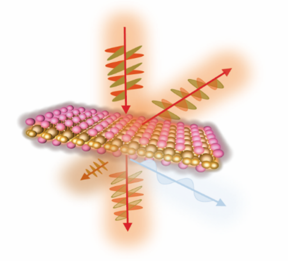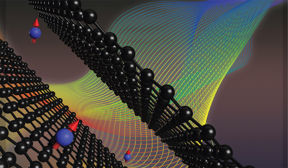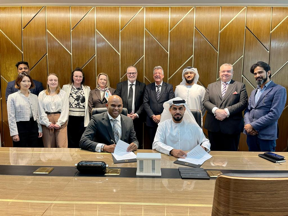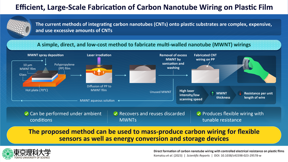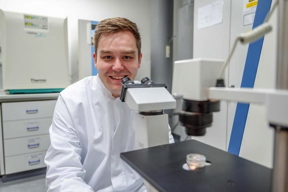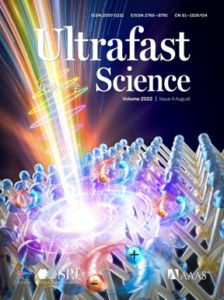Home > Press > Finding the most heat-resistant substances ever made: UVA Engineering secures DOD MURI award to advance high-temperature materials
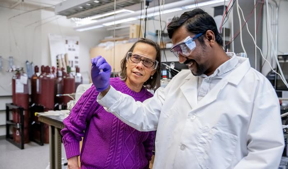 |
| Postdoctoral researcher Sandamal Witharamage (from left) is part of Professor Elizabeth J. Opila’s team developing novel planetary- and geologically inspired high-temperature materials under a Department of Defense Multidisciplinary University Research Initiative grant. CREDIT University of Virginia School of Engineering and Applied Science |
Abstract:
The most durable, heat-resistant materials ever made could be hiding in plain sight.
Finding the most heat-resistant substances ever made: UVA Engineering secures DOD MURI award to advance high-temperature materials
Charlottesville, VA | Posted on December 8th, 2023The U.S. Department of Defense wants to know if minerals and rocks found on Earth and in space hold the secrets of next-generation high-temperature materials. To find out, the DOD awarded $6.25 million through its Multidisciplinary University Research Initiative, or MURI, to a team from the University of Virginia and Arizona State University. The group is led by UVA’s Elizabeth J. Opila, the Rolls-Royce Commonwealth Professor and chair of the Department of Materials Science and Engineering.
The highly competitive MURI funds fundamental scientific research the DOD hopes will lead to breakthroughs in its areas of interest through collective insights from multiple disciplines.
Reading the Rocks
“It’s a boom time for high-temperature materials because of needs in energy production, hypersonics and new things like additive manufacturing coming on in the field,” Opila said. “[People are] exploring new compositional spaces where you’re mixing different elements in different ways. On top of that we’re thinking about this geologically and planetary-inspired materials, which is lots of fun.”
Minerals and rocks are complex compared to the compounds materials scientists usually work with, Opila said, and that’s why the project’s potential is exciting.
“The geologists are really focused on how the earth formed and where we can find these different substances,” Opila said. “We want to take that knowledge and bring it into the application space.”
Selecting for specific physical properties, the researchers will copy Mother Nature’s use of mineral composition, temperature, pressure, and the rapid changes in these forces, to make their synthetic materials. The goal is to dramatically expand, and document for others, the means and ingredients from which high-temperature materials can be processed to surpass anything yet conjured by people or nature.
On the Hunt for Refractory Materials
Addressing needs for ever-better refractory materials — those which resist weakening, melting or decomposing under intense heat or corrosive conditions, the Army Research Office called for proposals on Emergent Refractory Behaviors in Earth and Extraterrestrial Materials. Amongst several objectives, Opila’s team will design, make, test and describe a host of new materials meant to outperform current ceramics, alloys and coatings used in intensely hot environments — for example, a 3,000-degree jet engine.
Opila is a former NASA scientist and innovator in heat- and corrosion-resistant materials. Her collaborators are experts in geology, computational modeling and materials science from UVA’s School of Engineering and Applied Science and ASU’s schools of Engineering of Matter, Transport and Energy; Molecular Sciences; and Earth and Space Exploration.
Fast-Tracking Discovery
Opila’s co-principal investigators from UVA’s Engineering are Patrick E. Hopkins, the Whitney Stone Professor of Engineering in mechanical and aerospace engineering, and assistant professor of materials science and engineering Bi-Cheng Zhou.
Hopkins’ ExSiTE Lab specializes in laser-based techniques for measuring thermal properties. His lab will be instrumental in characterizing the materials the team comes up with.
Zhou is a computational modeler known for inventing variations on the CALPHAD method to expand its capabilities. He and another computational modeling specialist, ASU assistant professor in materials science and engineering Qijun Hong, will use their respective expertise to fast-track discovery of promising “recipes” for experimental labs to try at both schools.
The ASU labs are run by Alexandra Navrotsky, a renowned interdisciplinary expert in thermodynamics and director of the Navrotsky Eyring Center for Materials of the Universe, and Hongwu Xu, a mineralogist and materials chemist and professor in ASU’s schools of Molecular Sciences and Earth and Space Exploration.
The teams will make and analyze prospective recipes — often exchanging samples for testing, Opila said, with her lab bringing extreme heat, while the ASU labs apply intense pressure as well as high-temperature testing.
Clipping Coupons
Synthesis of test samples typically starts with an element in powder form, said UVA Ph.D. student Pádraigín Stack, which is chemically altered to isolate a target material, or a component of a target.
The new composition, which has been diluted, heated and dried back to a powder, is then sintered, a process applying enough heat and pressure to form a dense puck of material. Thin slices from the puck, called coupons, provide the samples researchers will subject to various tests — for example, exposing it to steam at high velocities in Opila’s lab or, at ASU, applying geological-like pressures with a diamond anvil.
In addition to these traditional synthesis methods, the team will try approaches inspired by planetary or geological phenomena, such as hydrothermal synthesis, which occurs in heated water at elevated pressures. Since water is abundant in Earth’s hot, pressurized interior, hydrothermal processes are associated with, for example, the formation of minerals containing rare earth elements — critical components for many renewable energy applications.
In the lab, hydrothermal synthesis involves forming crystals in a hot water-based solution in a closed vessel such that gaseous molecules moving atop the liquid exert high vapor pressure within the system.
The Dilemma of Rare Earth Elements
One focus of the MURI project is utilizing rare earth elements. Many rare earth elements are already used in conventional high-temperature materials, such as environmental barrier coatings in aviation and hypersonic flight, as well as batteries, LED devices and other increasingly in-demand products — but at a steep cost. While not actually rare, separating the elements from soil and rock requires dozens of steps, most of them polluting.
“All these rare earth oxides that we’re going to use are in minerals right now,” Opila said. “Somebody mines them and then they have to separate them all. For example, ytterbium and lutetium are neighbors on the periodic table. They are so chemically similar, it takes 66 steps involving many chemicals resulting in nasty waste products.”
The separation problem led Opila to ask a question at the heart of another project she and her students are working on that’s related to the MURI: “What if you take a mineral made of elements you want straight out of the ground but not separate them, just clean it up a bit and make your material from that?”
They’re experimenting with xenotime, a common mineral, to improve environmental barrier coatings, or EBCs, which protect jet engine parts from hazards like high-velocity steam and desert sand. Ingested sand can melt into glass and react with the underlying alloy if it infiltrates the coating.
“We know certain minerals are stable because we can find them in the ground,” Stack said. “You don’t find metallic iron in the ground, you find iron oxide because iron oxide is what’s stable. Let’s explore why something is stable, or if it has other useful properties, and use that knowledge to make something better.”
####
For more information, please click here
Contacts:
Jennifer McManamay
University of Virginia School of Engineering and Applied Science
Office: 540-241-4002
Copyright © University of Virginia School of Engineering and Applied Science
If you have a comment, please Contact us.Issuers of news releases, not 7th Wave, Inc. or Nanotechnology Now, are solely responsible for the accuracy of the content.
| Related News Press |
News and information
![]() World’s first logical quantum processor: Key step toward reliable quantum computing December 8th, 2023
World’s first logical quantum processor: Key step toward reliable quantum computing December 8th, 2023
![]() VUB team develops breakthrough nanobody technology against liver inflammation December 8th, 2023
VUB team develops breakthrough nanobody technology against liver inflammation December 8th, 2023
Possible Futures
![]() World’s first logical quantum processor: Key step toward reliable quantum computing December 8th, 2023
World’s first logical quantum processor: Key step toward reliable quantum computing December 8th, 2023
![]() VUB team develops breakthrough nanobody technology against liver inflammation December 8th, 2023
VUB team develops breakthrough nanobody technology against liver inflammation December 8th, 2023
Discoveries
![]() Thermal impact of 3D stacking photonic and electronic chips: Researchers investigate how the thermal penalty of 3D integration can be minimized December 8th, 2023
Thermal impact of 3D stacking photonic and electronic chips: Researchers investigate how the thermal penalty of 3D integration can be minimized December 8th, 2023
![]() Presenting: Ultrasound-based printing of 3D materials—potentially inside the body December 8th, 2023
Presenting: Ultrasound-based printing of 3D materials—potentially inside the body December 8th, 2023
Materials/Metamaterials/Magnetoresistance
![]() 2D material reshapes 3D electronics for AI hardware December 8th, 2023
2D material reshapes 3D electronics for AI hardware December 8th, 2023
![]() Porous platinum matrix shows promise as a new actuator material November 17th, 2023
Porous platinum matrix shows promise as a new actuator material November 17th, 2023
![]() A new kind of magnetism November 17th, 2023
A new kind of magnetism November 17th, 2023
Announcements
![]() 2D material reshapes 3D electronics for AI hardware December 8th, 2023
2D material reshapes 3D electronics for AI hardware December 8th, 2023
![]() VUB team develops breakthrough nanobody technology against liver inflammation December 8th, 2023
VUB team develops breakthrough nanobody technology against liver inflammation December 8th, 2023
- SEO Powered Content & PR Distribution. Get Amplified Today.
- PlatoData.Network Vertical Generative Ai. Empower Yourself. Access Here.
- PlatoAiStream. Web3 Intelligence. Knowledge Amplified. Access Here.
- PlatoESG. Carbon, CleanTech, Energy, Environment, Solar, Waste Management. Access Here.
- PlatoHealth. Biotech and Clinical Trials Intelligence. Access Here.
- Source: http://www.nanotech-now.com/news.cgi?story_id=57427
- :has
- :is
- :not
- :where
- $UP
- 10
- 17th
- 25
- 27
- 3d
- 66
- 7th
- 8th
- a
- About
- abundant
- accuracy
- acoustic
- actually
- addition
- additive
- additive manufacturing
- advance
- Aerospace
- aerospace engineering
- against
- AI
- All
- allen
- Alloy
- already
- altered
- amongst
- an
- analyze
- and
- Another
- ANVIL
- anything
- Application
- applications
- applied
- Apply
- Applying
- approaches
- ARE
- areas
- arizona
- Arizona State University
- Army
- AS
- ask
- Assistant
- associated
- At
- autonomous
- aviation
- award
- awarded
- back
- barrier
- batteries
- BE
- because
- been
- Better
- biology
- Bit
- boom
- both
- breakthrough
- breakthroughs
- bring
- Bringing
- but
- by
- called
- CAN
- capabilities
- Cells
- Center
- certain
- CGI
- Chair
- chan
- Changes
- chemicals
- Chips
- clean
- click
- closed
- collaborators
- Collective
- color
- COM
- comes
- coming
- comment
- Common
- commonwealth
- compared
- competitive
- complex
- component
- components
- composition
- computational
- computing
- conditions
- content
- contribution
- conventional
- Cost
- could
- created
- credit
- critical
- Current
- December
- Defense
- del
- delivery
- dense
- Department
- department of defense
- describe
- DESERT
- Design
- develop
- developing
- Development
- develops
- device
- Devices
- Diamond
- different
- diluted
- Director
- disciplines
- discover
- discovery
- Disease
- document
- DoD
- Dont
- dozens
- dramatically
- e
- earth
- effects
- Electronic
- Electronics
- element
- elements
- elevated
- elizabeth
- end
- energy
- Engine
- Engineering
- enough
- environmental
- environments
- Ether (ETH)
- EVER
- example
- exchanging
- exciting
- Expand
- experimental
- expert
- expertise
- experts
- exploration
- explore
- Exploring
- extreme
- field
- films
- Find
- finding
- findings
- First
- first time
- flight
- Focus
- focused
- For
- Forces
- forcing
- form
- formation
- formed
- Former
- found
- from
- fun
- fundamental
- funds
- futuristic
- generating
- gif
- glass
- goal
- going
- grant
- Ground
- Group
- Have
- he
- Heart
- her
- High
- highly
- his
- hold
- Hong
- hopes
- Hopkins
- host
- HOT
- How
- http
- HTTPS
- Hub
- hunt
- if
- Impact
- improve
- in
- Inc.
- increasingly
- individual
- inflammation
- information
- ingredients
- Initiative
- Innovator
- inside
- insights
- inspired
- Institute
- instrumental
- integration
- interest
- interior
- into
- investigate
- Investigators
- involves
- involving
- IT
- ITS
- jpg
- just
- Key
- Kind
- Know
- knowledge
- known
- lab
- Labs
- laser
- launched
- lead
- Led
- left
- lenses
- like
- links
- Liquid
- Liver
- logical
- lots
- made
- make
- manufacturing
- many
- material
- materials
- Matrix
- Matter
- means
- meant
- measuring
- mechanical
- method
- methods
- million
- mineral
- minerals
- mines
- Mixing
- modeling
- molecular
- more
- most
- mother
- moving
- mRNA
- multidisciplinary
- multiple
- nanotechnology
- Nasa
- Nature
- needs
- neighbors
- net
- New
- news
- next-generation
- novel
- November
- now
- objectives
- of
- Office
- often
- on
- or
- Other
- Others
- out
- Outperform
- part
- parts
- patrick
- People
- periodic
- PHP
- physical
- Plain
- platinum
- plato
- Plato Data Intelligence
- PlatoData
- please
- possibilities
- Post
- posted
- potential
- press
- Press Release
- pressure
- princeton
- printing
- Problem
- process
- processed
- processes
- processing
- Processor
- Production
- Products
- Professor
- project
- projects
- promise
- promising
- prompts
- properties
- Proposals
- prospective
- protect
- provide
- Quantum
- quantum computing
- quantum information
- question
- rapid
- RARE
- React
- really
- Recipes
- recording
- reduces
- related
- release
- Releases
- reliable
- Renewable
- renewable energy
- Renowned
- requires
- research
- researcher
- researchers
- respective
- responsible
- resulting
- return
- reveal
- right
- robots
- robust
- Rock
- Rolls-Royce
- Run
- s
- Said
- SAND
- Save
- School
- School of Engineering
- Schools
- Science
- SCIENCES
- scientific
- Scientific Research
- Scientist
- scientists
- Search
- secrets
- Secures
- sense
- Sensitivity
- sensor
- separate
- separating
- setup
- several
- Share
- she
- Shows
- Sight
- significant
- similar
- simultaneously
- since
- Skin
- So
- Soft
- soil
- solely
- solution
- something
- Space
- space exploration
- spaces
- specialist
- specializes
- specific
- speed
- stable
- stack
- stacking
- start
- starts
- State
- Steam
- Step
- Steps
- STONE
- straight
- structures
- Student
- Students
- Study
- subject
- submit
- such
- surpass
- synthesis
- synthetic
- system
- table
- Take
- takes
- Target
- team
- teams
- technique
- techniques
- Technologies
- Technology
- test
- Testing
- tests
- that
- The
- their
- Them
- then
- thermal
- These
- they
- things
- Thinking
- this
- those
- Through
- time
- to
- top
- toronto
- toward
- traditional
- transport
- try
- TURN
- typically
- u.s.
- U.S. Department of Defense
- under
- underlying
- Universe
- university
- university of washington
- unlock
- us
- use
- used
- uses
- usually
- Utilizing
- Vaccine
- variations
- various
- Vessel
- virginia
- want
- wants
- washington
- Waste
- Water
- Wave
- ways
- we
- wearable
- WELL
- which
- while
- why
- will
- with
- within
- Work
- working
- Yahoo
- yet
- you
- Your
- zephyrnet
- Zuckerberg











